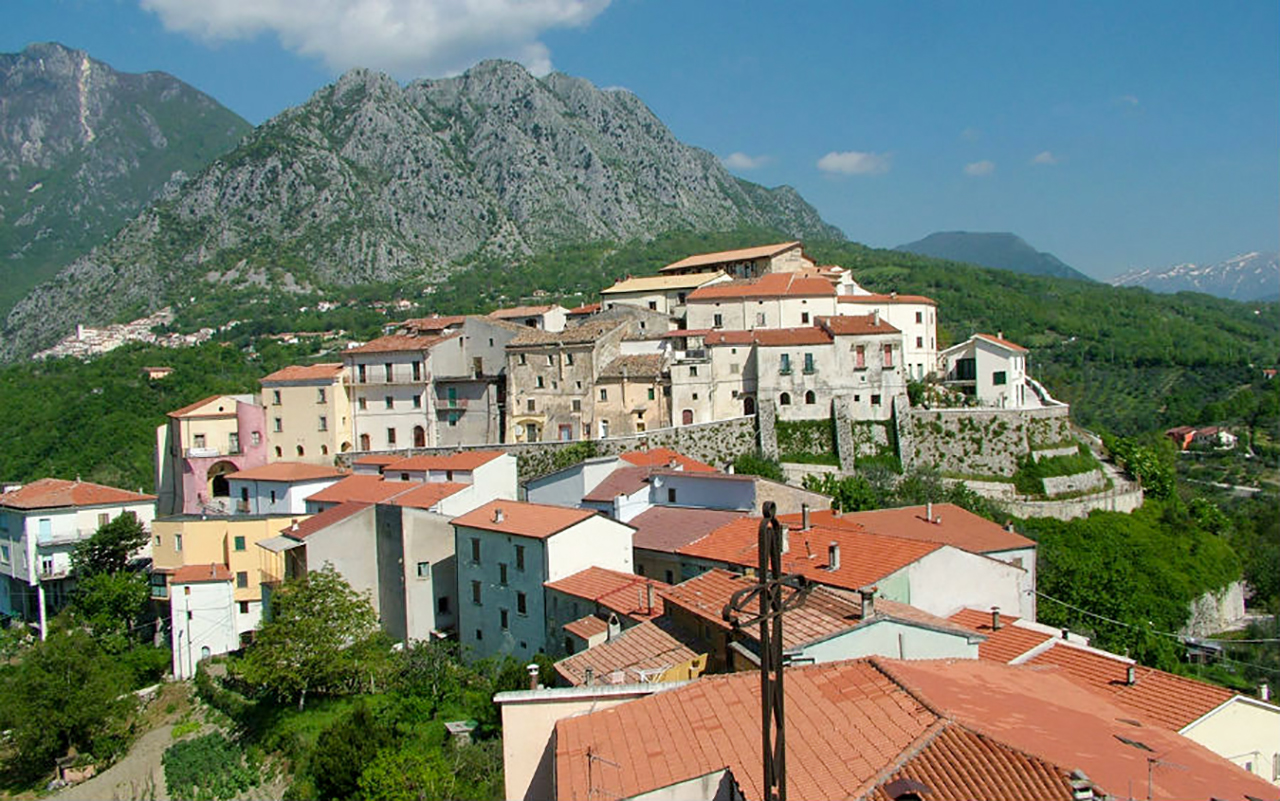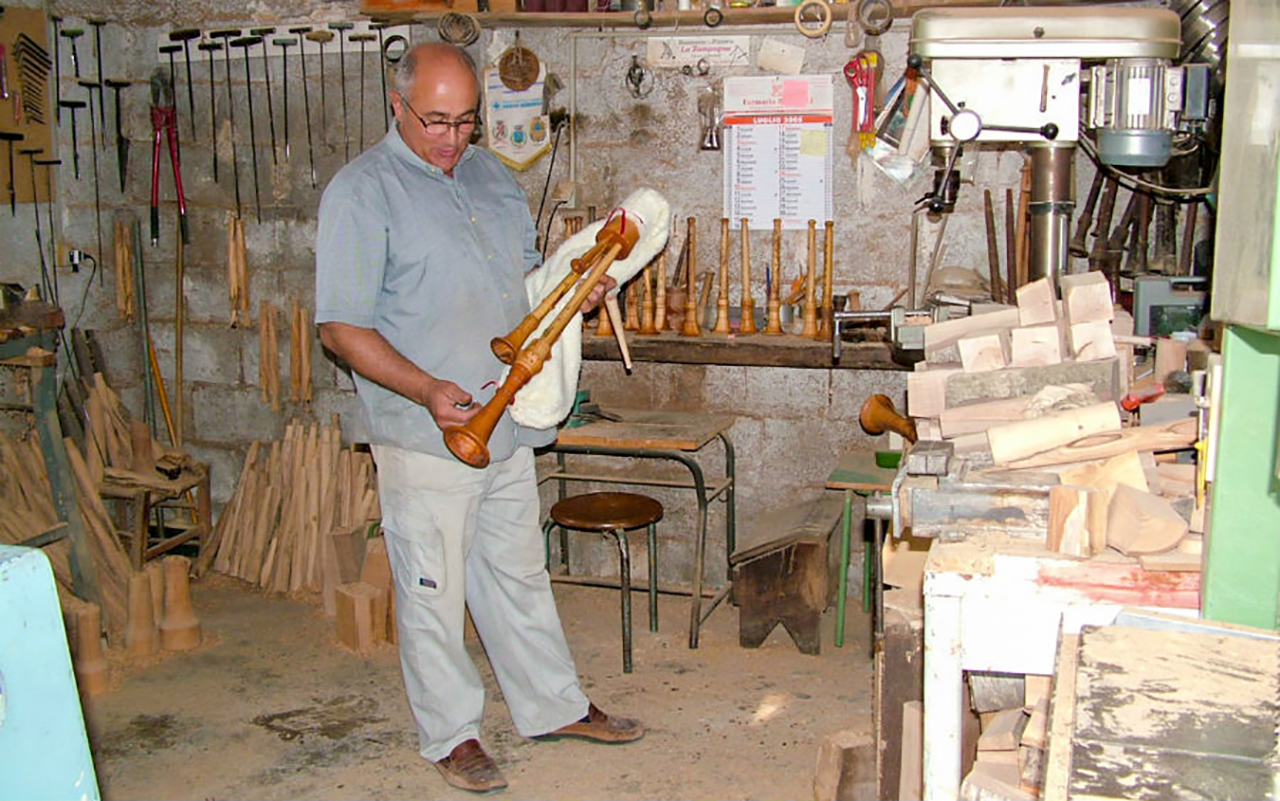
Scapoli

By Nancy DeSanti
Province of Isernia, Region of Molise
The town of Scapoli is located in the western area of the province of Isernia in Molise, near the region of Lazio. It has approximately 758 inhabitants.

Credit: e-borghi.com
The fame of Scapoli rests on a bagpipe known as a zampogna, an instrument invented by the Samnites and then used by the Romans to frighten the horses of the enemy. There are still workshops making this ancient instrument which, being the musical instrument of shepherds, was then connected to Christmas.
The town is notable for its bagpipes museum and for the international bagpipe festival which, each year in the month of July, attracts pipers from around the world to come and perform in Scapoli.
Two types of zampogna are made in Scapoli — “con chiave” (or “keyed” pipes) and “la zoppa” (or “lame” pipes). Historians say Emperor Nero especially loved to play an instrument known as “utriculus,” which was made with pipes inserted in a goat skin. Today, Scapoli is the only area in Italy that still has a solid and skilled production of zampognas, and the master craftsmen continue the Molise bagpipe-making tradition, jealously guarding the secrets of their ancient techniques.
Zampogna making follows established methods and techniques handed down over the centuries to younger generations by master craftsmen. After the selection and natural seasoning of olive and cherry wood, the various pieces that will make up the instrument are shaped on a lathe and with simple carpentry tools.

Credit: e-borghi.com
The small town rose on the sides of the Mainarde, on an elevated terrain relic of a prehistorical glacier. After the first destruction by the Saracens of the Abbey of San Vincenzo al Volturno in the 9th century, the surviving monks gathered the population away from the abbey and organized them in small farms called “curtes”, thus creating a network of fortified boroughs, among which was Scapoli.
Though always under the influence of the Abbey of San Vincenzo, Scapoli was ruled by a number of feudal lords, among them the Borrello, who ruled over the whole Volturno Valley until 1050 AD. Later, the fiefdom passed to the Caldora, the Pandone, then in the 15th century to the Bucciarelli family, until in 1626, when it was auctioned and given to Baron Innico di Grazia from Cerro al Volturno.
What to See
- The Church of San Giorgio, from the 17th century, recently restored
- The Lombard Fortress also known as Scarupato, which is a kind of pathway embracing the whole historical center.
- The Church of Santa Maria delle Grotte, on the road to Rocchetta a Volturno, immersed in an impressive natural landscape and having magnificent frescoes.
Important Dates
- April 23 — Feast of San Giorgio, the patron saint
- Last week in July — Festival Internazionale della Zampogna (bagpipe festival), with performances of zampogna and ciaramelle (bagpipes), still built as 2,000 years ago.
Italiano

Tradotto da Ennio Di Tullio
Provincia di Isernia , Regione Molise
Comune di Scapoli è situato nella zona occidentale della provincia di Isernia in Molise, a ridosso della regione Lazio. Ha circa 758 abitanti.
La fama di Scapoli si fonda su una cornamusa detta zampogna, strumento inventato dai Sanniti e poi utilizzato dai Romani per spaventare i cavalli del nemico. Ancora oggi esistono laboratori di lavorazione di questo antico strumento, che, essendo lo strumento musicale dei pastori, era poi legato al periodo natalizio.
La città è nota per il suo museo della zampogna e per il festival internazionale della zampogna che, ogni anno nel mese di luglio, richiama suonatori di cornamusa da tutto il mondo per esibirsi a Scapoli.
A Scapoli si producono due tipi di zampogna: “con chiave” (o pipe “a chiave”) e “la zoppa” (o pipe “zoppe”). Gli storici dicono che l’imperatore Nero amava particolarmente suonare uno strumento noto come “utriculus”, che era realizzato con tubi inseriti in una pelle di capra. Oggi Scapoli è l’unica zona in Italia che conserva ancora una solida e qualificata produzione di zampogne, e i maestri artigiani continuano la tradizione molisana della zampogna, custodendo gelosamente i segreti delle loro antiche tecniche.
La lavorazione della zampogna segue metodi e tecniche consolidate tramandate nei secoli alle giovani generazioni dai maestri artigiani. Dopo la selezione e stagionatura naturale del legno di ulivo e ciliegio, vengono modellati al tornio e con semplici attrezzi da falegnameria i vari pezzi che andranno a comporre lo strumento.
Il piccolo centro sorse sulle sponde delle Mainarde, su un terreno elevato relitto di un ghiacciaio preistorico. Dopo la prima distruzione da parte dei Saraceni dell’Abbazia di San Vincenzo al Volturno nel IX secolo, i monaci superstiti raccolsero la popolazione lontano da l’abbazia e li organizzò in piccole masserie chiamate “curtes”, così creando una rete di borghi fortificati, tra cui era Scapoli.
Pur essendo sempre sotto l’influenza dell’Abbazia di San Vincenzo, Scapoli fu governata da numerosi feudatari, tra cui i Borrello, che dominarono l’intera Valle del Volturno fino al 1050 dC. Successivamente il feudo passò ai Caldora, ai Pandone, poi nel XV secolo al Bucciarelli famiglia, fino al 1626, quando fu messo all’asta e ceduto al barone Innico di Grazia di Cerro al Volturno.
Le attrazioni del luogo:
- La Chiesa di San Giorgio, del XVII secolo, recentemente restaurata
- La Rocca Longobarda detta anche dello Scarupato, che è una sorta di viale che abbraccia tutto il centro storico
- La Chiesa di Santa Maria delle Grotte, sulla strada per Rocchetta a Volturno, immersa in un suggestivo paesaggio naturale e con magnifici affreschi.
Date da ricordare:
- 23 aprile — Festa di San Giorgio, patrono
- Ultima settimana di luglio — Festival Internazionale della Zampogna, con esibizione di zampogna e ciaramelle, costruite ancora come 2,000 anni fa
January/February 2023





